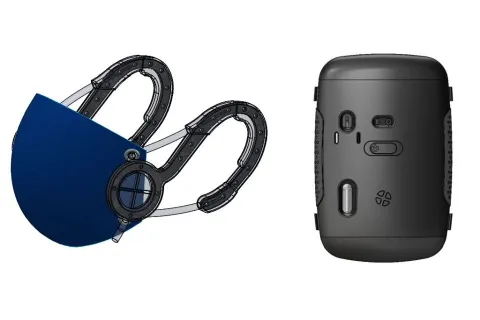Design + Innovation Day Award-winners: Department of Mechanical Engineering

Design + Innovation Day is UBC Engineering's annual showcase for student engineering design projects. Carried out in small groups over the previous academic year, the projects enable students to improve their technical, teamwork and management skills while designing solutions to real-world problems.
The most outstanding projects of the year are recognized with UBC Applied Science Faculty Awards. This week we are highlighting the top two teams from the UBC Department of Mechanical Engineering, which were selected for "the high quality of both the technical design work completed and the supporting design dossier documentation."
identifEye, the surgical instrument tracking device
Team members: Melissa Coleman, Janelle Lawson, Connor Schellenberg, Alexander Waslen
Community partner: Dr. Chris Nguan, UBC Urology
Our project
identifEye is a surgical instrument tracking device that uses computer vision to reduce the occurrence of retained surgical instruments (RSIs). RSIs pose serious health risks to patients and are considered an entirely preventable mistake. Current control methods require nurses to double-count the instruments before and after a surgery and record the counts on paper sheets. identifEye automates this process by using computer vision to identify and track instruments presented by a nurse.
Our inspiration
One of our team members previously worked on this project with Dr. Nguan, and we were excited by the opportunity to further this work and develop our skills with machine learning and computer vision techniques.
Our biggest challenge
Going into the project, our experience with machine learning was very limited and our team spent many hours familiarizing ourselves with various tools and techniques.
What excited us most
It was very exciting to be able to contribute to a technology that has the potential to improve operating room procedures and make a positive impact on patient safety.
The most interesting/surprising thing we learned
The numerous different methods for object recognition can have widely varying effectiveness and surprising results depending on how an image of an object is captured.
Our project's future
Our prototype will be used for a mock clinical trial to test the adoptability of computer vision technology into the OR.
Hands-free COVID-19 PPE
Team members: David Stewart, Ahmad Bin Manzoor, Faheem Saeed, Sachin Choudhury
Community partner: Tetra Society of North America
Our project
Our team has been tasked with making personal easy-to-use protective equipment for people with hand mobility limitations. They provide someone who has difficulty with masks and hand sanitizer bottles a more friendly option which was designed with their needs in mind. Our mask and hand sanitizer devices are easy to use and require less complex arm and finger movement than a standard mask or personal hand sanitizer bottle. These solutions can make navigating through our COVID world more tolerable for those who need it.
Our inspiration
We were interested in doing a project which was relevant to solving a practical problem during this global pandemic. People with disabilities have a difficult time interacting with basic PPE devices, which makes it harder to go through the day-to-day without being at risk. Our team was interested in this project because it wasn't a problem that was being looked at anywhere else, and it could really help people during a difficult time.
Our biggest challenge
The biggest challenge our team faced while working on this project was to set the scope of the project based on a particular target of users. Since people with quadriplegia can have a wide variety in terms of range of motion for the arms and hands, it was difficult to design to meet everyone's needs. Our team had to do extensive research and conduct interviews to focus on important features necessary for the device. With COVID present there wasn't any way for us to meet our users in person, assess their needs or do proper prototype validation, but we had to work with what we had.
Since our team was challenged with making two separate devices, we had to write extra documentation. Managing this was the difficult part; with two projects at once our focus was split into two paths.
What excited us most
The project's goal to design solutions to help people with disabilities in making their lives a little easier by giving them easy access to basic PPE is very exciting and rewarding. Since people with quadriplegia have a difficult time using this equipment, we are thrilled to help solve this challenging problem and increase their convenience. We were driven to design, build and test as much as we were able to in order to come to the best user-centered design solution.
The most interesting/surprising thing we learned
The most interesting thing would probably be how much communication it took to do this project entirely virtually. I think we took for granted just how effective it is sometimes to all be in the same room for work. Being able to share ideas or draw on a notepad virtually took us more time than we believed it would. There's a newfound appreciation for the designers, teachers, etc. who have been working this way for a year now.
Our project's future
With COVID nearing the end of its life there is less application for these devices now compared to the start of the pandemic. Eventually masks won't be needed in public anymore, and people will go back to a more normal life. Our devices can be improved and developed further within Tetra after the pandemic is over. Without proper in-person validation, the devices as they are now may not have reached their full potential. With these devices as a resource for Tetra, we hope that they may find a use for someone in the future outside the context of a pandemic.